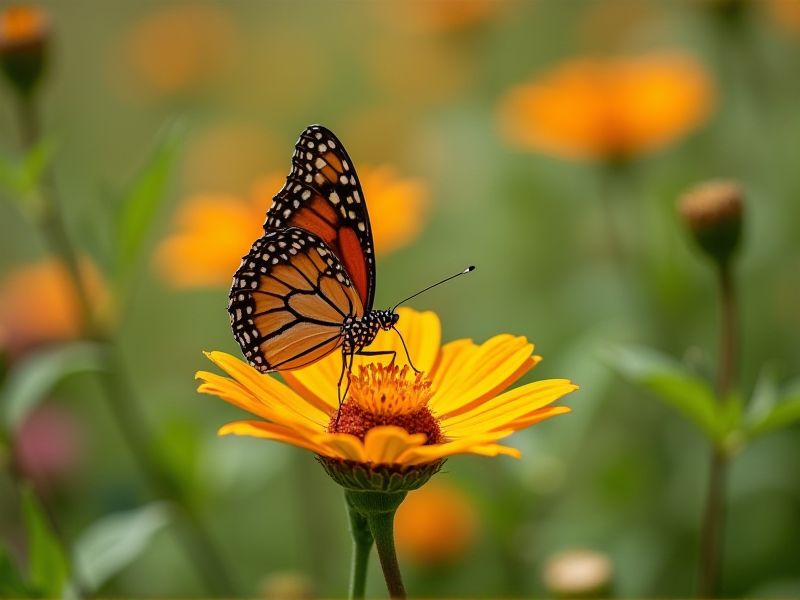
Drought-tolerant plants such as lavender, echinacea, and milkweed not only conserve water but also provide essential nectar sources for butterflies. Planting asters and lantanas further enhances your garden's appeal to various butterfly species due to their vibrant colors and aromatic blooms. Incorporating native plants like goldenrod and yarrow can support local ecosystems while requiring minimal water, helping to attract butterflies. These plants thrive in sunny locations and often have deep roots that access moisture, making them resilient in dry conditions. The combination of biodiversity and drought tolerance creates a sustainable garden that promotes butterfly populations.
List of some Butterfly-attracting plants that are drought-tolerant
- Butterfly Bush (Buddleja davidii)
- Lantana (Lantana camara)
- Blanket Flower (Gaillardia spp.)
- Lavender (Lavandula spp.)
- Yarrow (Achillea millefolium)
- Coneflower (Echinacea purpurea)
- Salvia (Salvia spp.)
- Coreopsis (Coreopsis spp.)
- Verbena (Verbena spp.)
- Zinnia (Zinnia spp.)
Important things about Butterfly-attracting plants that are drought-tolerant
Native Plant Species
Butterfly-attracting native plants that are drought-tolerant include species such as California lilac (Ceanothus spp.), which provides essential nectar for various butterfly species while thriving in dry conditions. Another excellent choice is the coneflower (Echinacea purpurea), known for its durability and ability to attract pollinators including butterflies with its vibrant blooms. The purple aster (Symphyotrichum spp.) not only offers a visual delight but also serves as a vital food source for butterflies during the fall migration period. Incorporating these plants into your garden supports local ecosystems and enhances the beauty of your outdoor space while conserving water.
Deep Root Systems
Butterfly-attracting plants with deep root systems, such as purple coneflower (Echinacea purpurea) and milkweed (Asclepias spp.), are excellent choices for xeriscaping. These plants not only provide essential nectar for caterpillars and adult butterflies but also thrive in dry conditions, ensuring sustainability in arid environments. Their extensive root networks enable them to access moisture deeper in the soil, reducing the need for supplemental watering. Incorporating such species into your garden design supports local butterfly populations while enhancing biodiversity and resilience in your landscape.
Minimal Water Requirements
Butterfly-attracting plants that are drought-tolerant typically feature intricate blooms and robust foliage, requiring minimal water to thrive. Examples include the vibrant Lantana, which not only attracts butterflies but also withstands dry conditions with ease. The native Milkweed, essential for Monarch butterflies, flourishes in arid soil while providing crucial habitats for caterpillars. By selecting these resilient plants for your garden, you can create a beautiful butterfly haven that conserves water and promotes biodiversity.
Pollinator-Friendly Flowers
Selecting butterfly-attracting plants that are drought-tolerant enhances your garden's sustainability while supporting essential pollinators. Some excellent options include the Lavender (Lavandula spp.), which produces aromatic blooms that draw in various butterfly species. Another great choice is the Butterfly Bush (Buddleja davidii), known for its vibrant flowers and long-lasting nectar supply. By incorporating these plants, you create a colorful, thriving ecosystem that conserves water and provides a vital habitat for butterflies.
Bright, Aromatic Blooms
Butterfly-attracting plants that are drought-tolerant include popular options like Lavender, Coneflower (Echinacea), and Lantana, all of which thrive in dry conditions while providing vibrant color and fragrance. These plants not only create a stunning garden display but also serve as essential food sources for butterflies and other pollinators. Incorporating these species into your landscape enhances biodiversity and supports local ecosystems. By choosing drought-tolerant plants, you can enjoy a lush garden with minimal water usage, making it an environmentally friendly choice.
Long Blooming Season
Butterfly-attracting plants with a long blooming season are ideal for creating vibrant gardens while conserving water. Species such as Lantana, Butterfly Bush (Buddleia), and Coneflower (Echinacea) not only provide nectar for butterflies but also thrive in dry conditions. Incorporating these drought-tolerant plants into your landscape can support local ecosystems, attracting various butterfly species throughout the warmer months. To enhance your garden's appeal, consider planting a diverse mix of colors and heights, ensuring continuous blooms and a lively habitat for these beautiful pollinators.
Hardy Foliage
Drought-tolerant butterfly-attracting plants such as Milkweed, Coneflower, and Lantana not only support pollinator populations but also thrive in arid conditions. Milkweed serves as the host plant for the Monarch caterpillar, providing crucial nourishment and habitat. Meanwhile, Coneflowers offer vibrant blooms rich in nectar, enticing various butterfly species to your garden. By incorporating these hardy plants, you can create a vibrant ecosystem while conserving water resources effectively.
Soil Improvement Capabilities
Butterfly-attracting plants that are drought-tolerant not only draw these beautiful pollinators but also enhance soil quality through natural processes. Varieties such as lavender, coneflower, and yarrow thrive in low-water conditions, helping to reduce erosion and improve soil structure. Their extensive root systems promote better aeration and nutrient absorption, benefiting the surrounding ecosystem. Incorporating these resilient plants into your garden can lead to a vibrant habitat while simultaneously improving soil health.
Attracts Various Butterfly Species
Drought-tolerant plants such as Lantana, Blanket Flower, and Agastache are excellent choices for attracting diverse butterfly species to your garden. These resilient plants thrive in arid conditions, providing essential nectar sources for butterflies like the Monarch, Swallowtail, and Painted Lady. By incorporating these vibrant, low-water plants into your landscape, you not only support local wildlife but also create a visually stunning habitat. The combination of color and fragrance from these butterfly-attracting plants will enhance your outdoor space while promoting biodiversity.
Supports Ecosystem Diversity
Butterfly-attracting plants, such as Lavender (Lavandula), Echinacea, and native milkweed species, play a crucial role in promoting ecosystem diversity. These drought-tolerant flora not only provide essential nectar sources for butterflies but also support a variety of pollinators, contributing to healthy ecosystems. Incorporating these plants into your garden can enhance local biodiversity, encouraging the presence of different butterfly species while requiring minimal water resources. Such sustainable gardening practices help combat climate change and foster resilient landscapes that can thrive under drought conditions.
